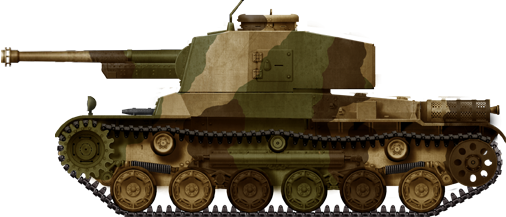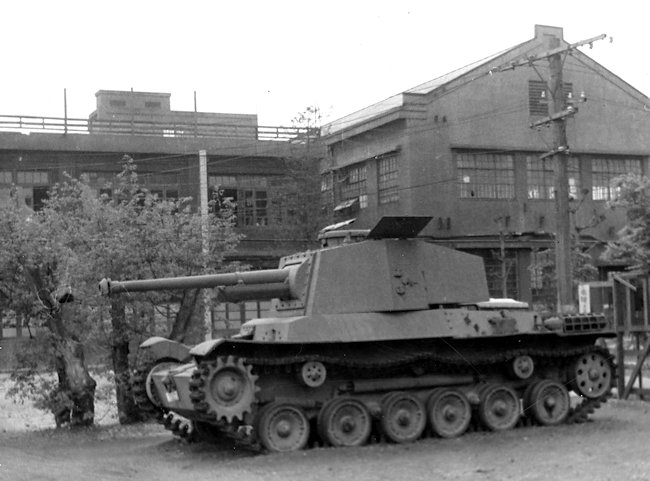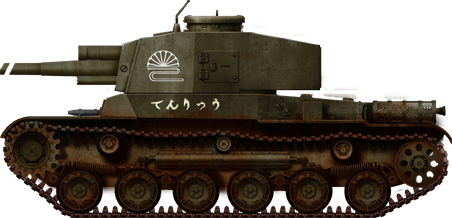Type 3 Chi-Nu
 IJA (1944-45) Medium tank - 144 built
IJA (1944-45) Medium tank - 144 built

A response to the Sherman
Called the Chi-nu, this new model was devised as early as 1943, when it became apparent that even the high-velocity 47 mm (1.85 in) gun on the Type 97 Chi-Ha Kai would not be enough against the Sherman's frontal armor.
Captured Type 3 Chi-Nu Tank Tokyo 1948 (photo - 1st Lt Kingston Winget, US 24th Infantry Regiment)
The Type 1 Chi-He, also based on the Type 97 Chi-Ha Kai, was quite an improvement in hull construction and armor, but fielded the same gun and was not ready until 1943. The army decided to shorten the development of its successor by taking the same mass-produced Type 97 chassis, upgraded to the Type 1 standard, and house the Type 3 75 mm (2.95 in) tank gun in a new turret. The Chi-Nu seemed the right response against the Sherman, fielding a comparable gun, and was produced to some extent, but never saw combat.
Design
The initial Army Technical Bureau program, the future Type 4 Chi-To, was not ready on schedule, accumulating problems and production delays. So much so that the army decided to produce a stopgap tank, based on the existing and improved Type 1 chassis. The main gun itself was a stopgap weapon, derived from Type 95 field artillery gun, itself derived from the French Schneider 75 mm (2.95 in) field gun of WW1 fame. It was adapted as the Type 90 and, due to the short life of its barrel, was modified to have a lower muzzle velocity. The gun elevation was -10 +25 degrees and had a muzzle velocity of 680 m/s (2,200 ft/s). It could defeat 90 mm (3.5 in) of armor at 100 m (110 yd) and 65 (2.56 in) at 1000 m (1100 yd). This armament was completed by a hull-mounted 7.7 mm (0.3 in) Type 97 machine gun.
A captured Type 3 Chi-Nu in Tokyo after the war. (photo taken in Tokyo 1948 - 1st Lt Kingston Winget, US 24th Infantry Regiment)
The Type 3 chassis was very similar to that of the Type 97 Chi-Ha, but slightly longer and wider, with thicker side armor and a 50 mm (1.97 in) strong frontal glacis. The suspension counted six roadwheels sprung by two horizontal coil springs and a bell crank, with three return rollers per side. The hexagonal turret was brand new, made of welded plates, 50 mm (1.97 in) thick (front). There was a commander cupola similar to the Type 1 Chi-He and Type 97 Chi-Ha Kai, equipped with a rotatable ring arm mounting a regular Type 97 machine-gun for AA close defense. The crew was composed of the commander, gunner, loader, driver and hull-gunner. The engine was a Mistubishi V-12 Type 100.
Production and service
The program was started in May 1943 and was completed by October, which was a record in itself. Mitsubishi was chosen for production, painfully delivering 55 vehicles in 1944 and 89 until the last days of the war, due to shortages of steel and the priority given to battleship construction. Due to the slow delivery rate, training and the loss of sea dominance, the tanks were never sent abroad. They equipped Kyūshū and Honshū home islands' 1st and 4th Armored Divisions based around Tokyo, with 6 tank regiments in total (around 140 tanks at the end of the war). These vehicles were kept for training, but were mostly static due to increasing gasoline shortages.In case of the awaited Allied invasion, they would have been deployed for massed counter-attacks, but the Japanese surrender ended those prospects and the Type 3 never saw action. A single vehicle escaped scrapping and is now displayed at the JGSDF Military Ordnance Training School at Tsuchiura, Ibaraki province. A single Chi-Nu received the Chi-To turret along with its Type 5 main gun, and it was tested at the Irago Firing Ground, being found satisfactory. However, no further vehicles were produced. After the war, this variant became known as the Chi-Nu Kai.
Sources
Family photo collection of Kingston Montgomery Winget Japanese Tanks 1939-45 by Steven J. ZalogaLinks
The Chi-Nu on Wikipedia.The Chi-Nu on WWII Vehicles
Extra photos on the Hungarian Wikipedia page
Type 3 Chi-Nu specifications |
|
| Dimensions | 6.73 x 2.87 x 2.87 m (22x9.5x9.5 ft) |
| Total weight, battle ready | 19.1 short tons (42,000 lbs) |
| Crew | 5 (driver, commander, gunner, loader, hull gunner/radio) |
| Propulsion | Mitsubishi Type 100, 21.7 l, V-12 diesel, 240 hp (179 kW) @ 2,000 rpm |
| Speed | 39 km/h (24 mph) |
| Armor | 12 to 50 mm hull & turret (0.47-1.97 in) |
| Suspension | Bell crank |
| Armament | 75 mm (2.95 in) Type 3 gun
1 x Type 97 7.7 mm (0.3 in) machine-gun |
| Range | 210 km (130 miles) |
| Total production | 144 |

Standard Type 3 Chi-Nu with the army camouflage, 4th Armored Division, Kyu-Shu, late 1944.

Up-gunned Type 3 Chi-Nu Kai, testing the Type 5 75 mm (2.95 in) Tank Gun, mid-1945.
Gallery

Type 3 Chi-Nu at the JGSDF Military Ordnance Training School at Tsuchiura, Ibaraki- Credits: Wikipedia




WW2 Tanks




























WW2 tanks posters

All Tiger tanks liveries.

Panther liveries and variants

WW2 Armour - All tanks











Tanks aces and single tanks series

Find more there

Museums, Movies, Books & Games
The Tanks and Armor in pop culture
Tanks and armored vehicles in general are only really grasped when seen first person: The mass, the scale, it's all there. Explore also the way tanks were covered in the movie industry, in books and in video games.Movies:
Best tanks movie on warhistoryonline.com
On imdb.com
On bestsimilar.com/
miltours.com
liveabout.com/
watchmojo.com
Video Games:
pcgamesn.com
historyhit.com
levvvel.com
vg247.com/best-tank-games
mmobomb.com/
alienwarearena.com
